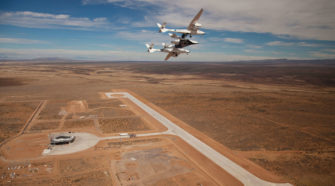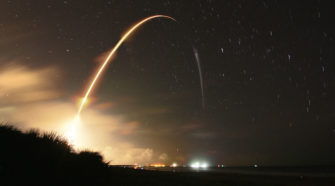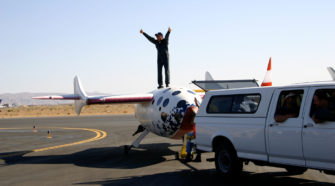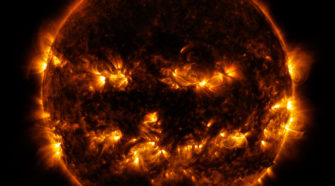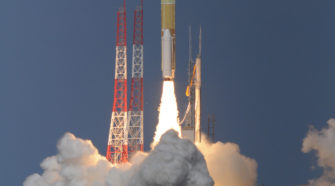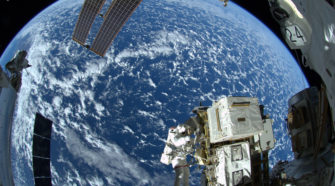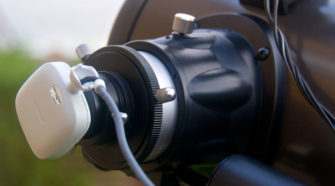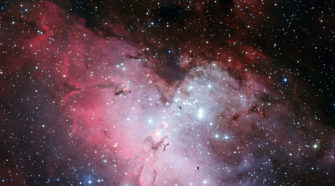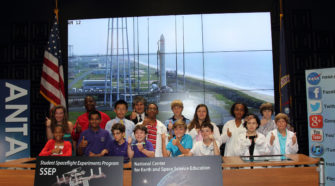Issue #9 (October 2014)
Gliding a spaceship back to Earth
Vocabulary • Altitude: The distance a spacecraft is above a given point on the ground • Distance From Spaceport: The ground distance from the edge of the runway to the spacecraft • Glide Distance: The distance the Landing Laser measures to the spacecraft • Glide Slope (Ø): The angle a spacecraft makes to the horizontal …
SpaceSHOT: SpaceX CRS-4 launch
A SpaceX Falcon 9 rocket with a Dragon cargo spacecraft on top launched from Cape Canaveral Air Force Station’s Space Launch Complex-40 in Florida at 1:52 a.m. EDT, Sept. 21, 2014. In this four-image composite, the launch, second stage burn to orbit and the Falcon-9 vertical soft landing test are all visible. As part of …
The Chalkboard: SpaceShipOne curriculum connections
After reading the SpaceShipOne retrospective, ask students to respond to questions that require analysis, evaluation, and synthesis. These questions connect to the Common Core State Standards, English Language Arts Reading: Informational Text standards. How has SpaceShipOne made a difference in space travel? Or has it? Defend your response. The author concludes, “From suborbital flight to …
SDO images ‘jack-o’-lantern’ Sun
Active regions on the sun combined to look something like a jack-o-lantern’s face on Oct. 8, 2014. The active regions appear brighter because those are areas that emit more light and energy — markers of an intense and complex set of magnetic fields hovering in the sun’s atmosphere, the corona. This image blends together two …
JAXA launches Himawari-8 weather satellite
Mitsubishi Heavy Industries, Ltd. and the Japan Aerospace Exploration Agency (JAXA) launched the H-IIA Launch Vehicle No. 25 (H-IIA F25) with the Geostationary Meteorological Satellite “Himawari-8” onboard at 2:16:00 p.m. on October 7, 2014 (Japan Standard Time, JST) from the Tanegashima Space Center. The launch vehicle flew as planned, and, at about 27 minutes and …
Astronaut Reid Wiseman on the first spacewalk of Expedition 41
On Oct. 7, NASA astronaut Reid Wiseman (pictured here) and European Space Agency astronaut Alexander Gerst completed the first of three spacewalks for the Expedition 41 crew aboard the International Space Station. The spacewalkers worked outside the space station’s Quest airlock for 6 hours and 13 minutes, relocating a failed cooling pump to external stowage …
How to photograph the planets
For the last couple of issues our object spotlights have been located within our solar system. It is quite easy to see them, Jupiter and the Moon in particular, but quite difficult to image them. The term for imaging the solar system is Planetary Imaging despite the fact that both the planets, the moon and …
M16: The Eagle Nebula
The Eagle Nebula is located in the constellation Serpens and is one of the most iconic star forming regions in our galaxy. The nebula is also known as Messier 16 or M16 in the catalog of celestial nebulas and star clusters compiled by French Astronomer Charles Messier. This is probably one of the most famous …
A look at ‘The Last Man on the Moon’
The Time: 19.30 GMT Wednesday, June 4th 2014. The Place: London’s Science Museum. Silence and darkness is broken by the Houston skyline. At a livestock auction a white haired cowboy appraises the cattle stock before settling into a stadium seat at a Houston Rodeo Show. One by one the rodeo riders enter the stadium, holding …
SSEP: Sending student experiments to the ISS
On the morning of July 12, 2014, the Orbital Science Antares rocket sits on Pad 0A at NASA’s Wallops Island facility awaiting to be hopefully be launched at 12:52 p.m. that afternoon. On top of the rocket is Orbital’s Cygnus ORB-2 spacecraft packed with cargo bound for the International Space Station. The spacecraft has been …

